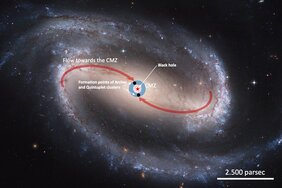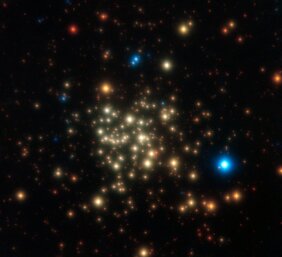A team of scientist lead by Dr Mattia Sormani (ZAH/ITA) used cutting-edge hydrodynamical simulations to understand the gas dynamics and star formation activity in the Milky Way's central molecular zone (CMZ), the star-forming nuclear ring surrounding the centre of our galaxy.
The centre of the Milky Way resembles the eye of a storm. In its centre lurks a black hole comprising the mass of a few million suns. The eyes iris is formed by a ring of interstellar gas at a distance of ~500 light years from the black hole. Within this ring, called Central Molecular Zone (CMZ), extraordinary star formation processes are observed. Along both sides of the Galactic bar molecular gas is transported towards the CMZ, where it is transformed into stars and star clusters (see Figure). A whole suite of astrophysical processes is in action whose complex interplay can only be understood in a numerical approach.
A team of astrophysicists lead by Dr Mattia Sormani and Robin Tress from the collaborative research centre SFB 881 at the Institute of Theoretical Astrophysics (ITA) of the Centre for Astronomy of Heidelberg University (ZAH) now used cutting-edge hydrodynamical simulations to understand the gas dynamics and star formation activity in the Milky Way's Central Molecular Zone. For the first time the scientist were able to resolve structures smaller than 1 light year while retaining the larger scale flow in which the CMZ is embedded, leading to important insights into how the small scales are affected by the larger scale environment.
Supernovae push gas into the centre
Gas accreting onto supermassive black holes, such as the one that sits at the centre of the Milky Way, fuels the most powerful engines in the universe. Yet, a major unsolved question in astrophysics is how the gas is transported from the CMZ of galaxies down to the are of influence of supermassive black holes. The work of Dr. Sormani provides an important piece to solve this puzzle. He and his colleagues were able to quantify for the first time to what extent supernova explosions contributes to transporting the gas from the CMZ inwards and found that it is very significant. The inflow rate is determined to be about 0.03 solar masses per year. “Although this is considerably smaller than the inflow from the outer disc onto the CMZ, this rate is still quite significant, as at this rate the build-up of the circum-nuclear disc, the closest large reservoir of molecular gas to Sag A*, would only take a very short time”, explains Tress. At a distance of just a few light years, the circum-nuclear disc is the last pit-stop of the gas before reaching SgrA*. “It will be interesting to look at how the gas leaves the circum-nuclear disc to go towards Sag A*, something we unfortunately cannot address with this simulation, but will look into in the future”, Tress supplements.
In their simulations, the astrophysicists were for the first time able to resolve the structure within individual molecular clouds formed self-consistently from the large-scale Galactic flow. “We were surprised to see that the Molecular clouds exhibit complicated filamentary morphologies which does not resemble the idealized “spherical clouds” that are often used as a model to understand star formation”, states Dr. Sormani. “These models should be used with care if one wants to understand star formation processes.”
Using their numerical setup, the researchers also studied the temporal and spatial distribution of star formation in the CMZ. In contrast to previous interpretations, the researchers did not find that stellar feedback can drive strong oscillatory star formation cycles, at least not within the timescale of the simulation run, which covers 100 Million years. They also tested the predictions of the three main scenarios that have been put forward to explain the spatial and temporal distribution of star formation in the centre of barred galaxies, namely the “pearls on a string", the “popcorn" and the “pericentre passage" scenarios.
Star formation resembles "Popcorn and Pearls on a string scenario"
“We found that our simulations reveal a mixture of the pearls on a string and popcorn scenarios, while they are inconsistent with the pericentre passage scenario” explains Dr Sormani. In the latter, star formation is triggered when the clouds are compressed while they pass closest to the Galactic centre while orbiting in the elliptically shaped CMZ ring. This scenario is at variance with the “popcorn” and the “pearls on a string” scenario. In the “pearls on a string” scenario, star formation occurs predominantly downstream of the contact point between the dust lanes and the CMZ ring (see Figure). In the “popcorn” scenario, star formation occurs uniformly along the ring.
The astrophysicist have also studied the trajectories of newly born stars and used this to provide a detailed analysis of the origin of the famous Arches and Quintuplet star clusters, which represent the densest known star clusters in the Milky Way. They are located close to the heart of the Milky Way and are only a few million years old. These clusters are so dramatically packed with stars that on the distance between the Sun and its nearest star, Proxima Centauri, one would pass over 100,000 stars if it were in the Arches cluster! A few hundred of their stars are among the brightest ever discovered in the Milky Way. These are so bright that they will burn their fuel within a short time of a few million years and then terminate in supernova explosions. The simulation favours a scenario in which the both the Arches and Quintuplet clusters originate from gas that crashed from the dust lanes onto the CMZ, but on the opposite side of the Galactic centre (see figure and image download below).
Original Publications
- Simulations of the Milky Way’s central molecular zone – I. Gas dynamics, Robin G Tress, Mattia C Sormani, Simon C O Glover, Ralf S Klessen, Cara D Battersby, Paul C Clark, H Perry Hatchfield, Rowan J Smith, Monthly Notices of the Royal Astronomical Society, Volume 499, Issue 3, December 2020, Pages 4455–4478, https://doi.org/10.1093/mnras/staa3120
- Simulations of the Milky Way’s Central Molecular Zone – II. Star formation, Mattia C Sormani, Robin G Tress, Simon C O Glover, Ralf S Klessen, Cara D Battersby, Paul C Clark, H Perry Hatchfield, Rowan J Smith, Monthly Notices of the Royal Astronomical Society, Volume 497, Issue 4, October 2020, Pages 5024–5040, https://doi.org/10.1093/mnras/staa1999
Videos of the Simulations are available at https://www.youtube.com/channel/UCwnzfO-xLxzRDz9XsexfPoQ
Images in higher resolution
Image and Sketch of NGC1300
Image of Arches Custer
Contact
Dr Guido Thimm
Zentrum für Astronomie der Universität Heidelberg (ZAH)
- ZAH Outreach -
thimm(at)uni-heidelberg.de


